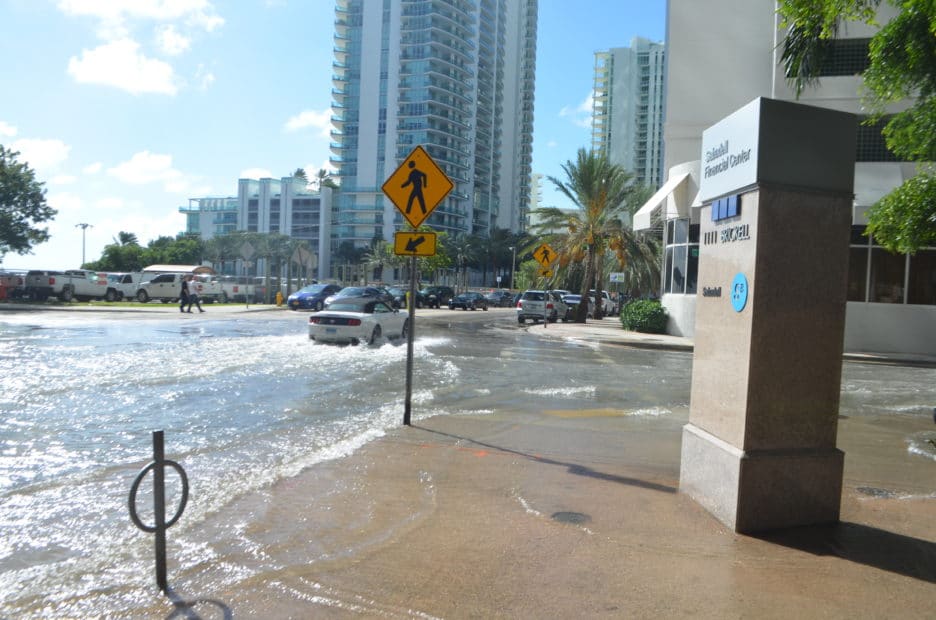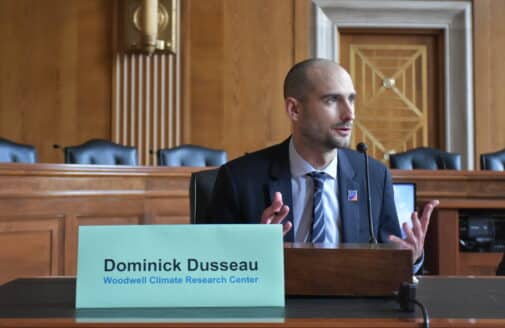Corporate climate risk assessment should be standardized and transparent
Woodwell responds to SEC's request for input on climate change disclosures

Sunny day high tide nuisance flooding in downtown Miami, Florida.
Photo credit: B137, CC BY-SA 4.0 via Wikimedia Commons
The following was provided to Commissioner Allison Herren Lee of the United States Securities and Exchange Commission on June 11, 2021.
Climate Change Is a Material Risk to Public Companies
Climate change risk to business includes transition risks as well as current and future physical climate risk. The SEC should ensure that any disclosure framework addresses all of these categories. Our comments will address the materiality of physical climate risk.
The average global surface temperature has already increased by 1.2°C above the pre-industrial baseline level. That temperature increase makes previously unlikely extreme heat events much more likely, and also sets in motion a wide variety of related impacts, from changes in wildfire risk to advancing sea level rise. Climate change hazards pose a significant physical threat to business infrastructure and supply chains.
As a climate science organization, we see a clear need for a standardized and transparent climate risk disclosure framework.
Because of our extensive work with Wellington Management and other large private sector partners, we know that business leaders want and need climate risk information for their decision making and planning. Asset managers, for example, want to consider climate risk in evaluating potential investments. Our work on quantifying the scope and scale of impending climate change impacts has made it clear that climate change impacts are a material risk for issuers of public securities and other businesses.
Physical Climate Risk Disclosure Should Be Standardized, Transparent, and Rigorous
The science of physical climate risk modeling is growing and evolving rapidly, with academic and non-profit researchers vigorously advancing the state of knowledge, and a wide spectrum of for-profit service providers offering risk assessments. Without clear standards from the SEC, many companies will seek the cheapest or easiest available option available to meet risk disclosure requirements. Without transparency around risk assessment methodologies, investors, regulators, and others will have no assurance that the information they are receiving is scientifically sound.
Clear standards around the disclosure of material climate risks should be supplemented by clear and consistent standards around the evaluation process of climate risks. Different parties may have different judgments about which physical climate risk could be considered material, and also about how to measure and assess those risks. A standardized risk assessment and evaluation process will allow for comparison across different companies and will aid investors in their analysis.
Standards for assessment of physical climate risks should cover choice of risk models, selection of appropriate time horizons, and choice of scenario for future emissions of greenhouse gases (and other climate drivers). Models should be restricted at a minimum to those which have been published in mainstream peer-reviewed scientific literature, and more specific restrictions may additionally be advisable. Choice of time horizon is important and is discussed below. Choice of scenario for future greenhouse gas emissions becomes important on longer time horizons (e.g. 30 years). We suggest that in order to illustrate near-worst case risks, that use of the most carbon-intensive scenario adopted by the Intergovernmental Panel on Climate Change (IPCC) be mandated. To illustrate the impact of aggressive climate-control policies, the use of a lower-emissions scenario is also warranted. Quantifying the cost of inaction (no climate policy) is necessary to address opportunity costs and provides necessary information for each business entity to understand their own risk appetite. It is important to note that while physical and transition risk are often assessed separately (see, for example, Network for Greening the Financial System guidance), quantifying physical climate risk is foundational. Scenarios focused on disorderly vs orderly transitions to a low-carbon future will not provide insight on physical risks. Using “business-as-usual” and aggressive climate-control scenarios from the IPCC canon alone ensures actionable climate intelligence on physical risks.
The perils of a non-standardized approach to assessing climate risk are particularly acute for the issue of time horizon. As the Commodity Futures Trading Commission report “Managing Climate Risk in the U.S. Financial System” states, disclosure in SEC filings have been inadequate because “materiality under U.S. law is often interpreted as limiting required disclosure to short- and medium-term risks.” Companies should be transparent about the time horizons they are using to assess climate risks and aim to disclose those risks across standardized and consistent time horizons as to address investors with varying fiduciary duties (current risk, 10 years from present day, and 30 years from present day).
In June 2021, Woodwell and Wellington released the P-ROCC2 framework, which advises companies on how to disclose their physical climate risks prior to materiality assessment. We recommended the disclosure of time horizon, key assumptions (including climate data and assumptions), and physical attributes of the company’s business.
We also believe the SEC should require companies to disclose their approach to transition risks in accordance with the Task Force on Climate-Related Financial Disclosures (TCFD). The sector-specific supplemental guidance provided by TCFD also provides clarity about what is expected from investors.
Information on Climate Risk That Can Be Quantified and Measured
Information related to physical climate risks that can be quantified and measured includes:
- Projected future physical climate change risks to company operations, using standardized and publicly available physical climate risk models, emission scenarios, time horizons, methods and data.
- Physical climate change risk for critical supply chains or supporting infrastructure, using standardized and publicly available scenarios, methods and data.
- Past losses and disruptions from weather and climate events.
Energy and water usage attributed to different production locations. - Disclosure of insurance coverage associated with different locations.
- Changes in revenue associated with climate risks and opportunities.
- Locations of important physical assets.
Companies are vulnerable to a wide variety of climate change driven hazards—both in their specific locations and because of the systems that they rely on. The SEC should require risk assessments that reflect this localized vulnerability as well as systemic risk originating from supply chains both up and downstream.
To ensure robust and rigorous climate risk assessments, the SEC should require that these risk assessments are conducted using a standardized approach and publicly available methodology and data.
Through our physical climate work with Wellington, we’ve found that the availability of company location data is the most important limiting factor in understanding the climate exposure of companies. In our recently published P-ROCC2 report, we call for companies to disclose their physical locations.
Similarly, we believe that disclosure of the energy, water use, insurance coverage, and historical impacts of climate change at different operating locations will also enable users to have a better understanding of the physical climate risk exposure of companies. We also believe that disclosure of business continuity plans in the face of acute climate risks is important.
We acknowledge that extensive climate disclosure requirements will penalize smaller and newer firms. For this reason, we support giving more phase-in time to smaller issuers to disclose on metrics that may not be as accessible.
Climate disclosure is instrumental for investors like Wellington to enable effective engagement with management and credible implementation of investment and asset allocation decisions based on climate issues. In the same vein, climate disclosure is also instrumental for companies that hope to access lower costs of capital, because clear climate disclosure is becoming a prerequisite for investors as sustainability objectives move to the forefront of investing.
We appreciate the Commission’s initiative in reviewing issuer climate risk disclosure. As a climate change science organization, we see a clear need for a standardized and transparent climate risk disclosure framework. A rigorous and properly constructed framework can provide investors with key material information necessary to evaluate their investments.







